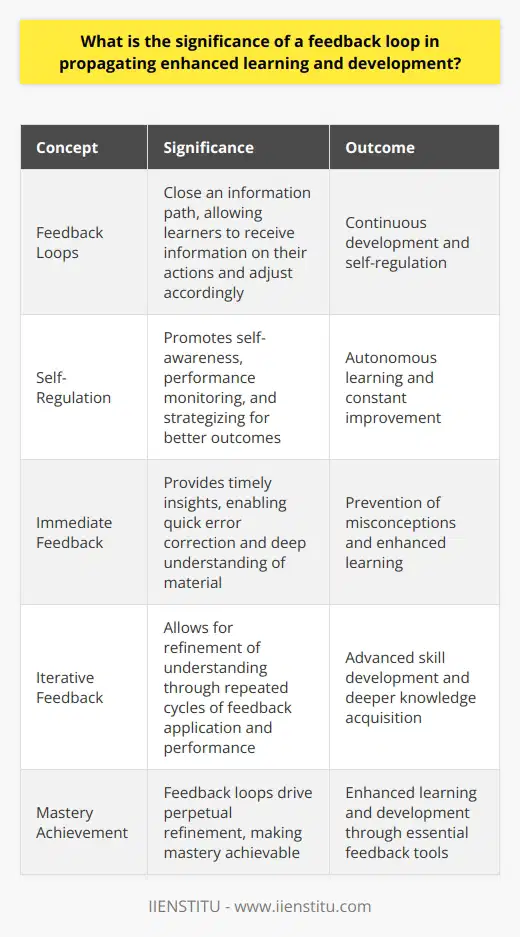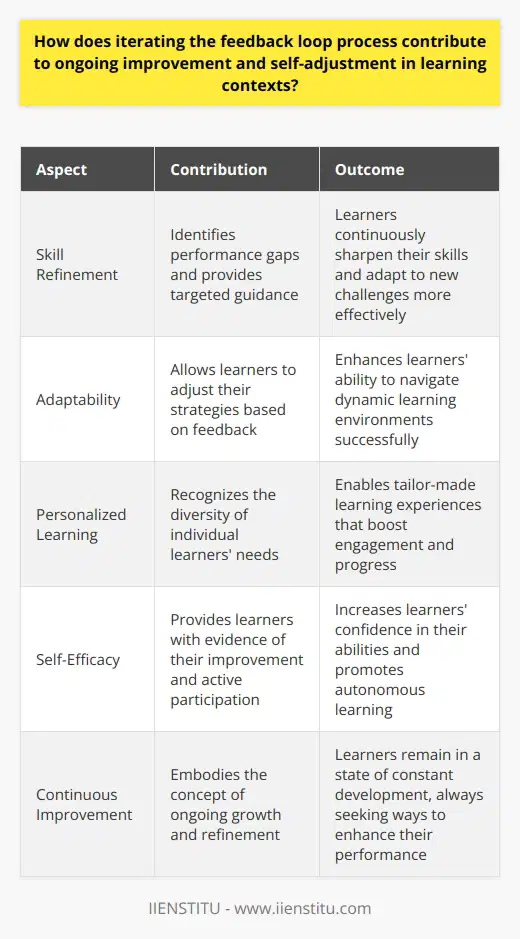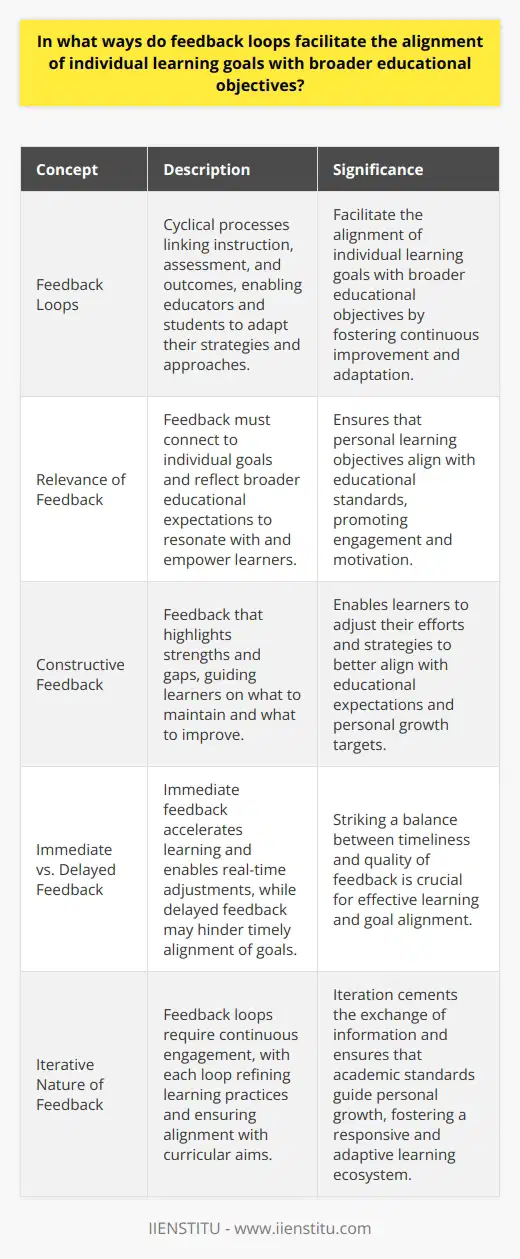
In the ever-evolving landscape of learning and development, the utilization of feedback loops is a seminal factor in fostering improvement and innovation. By definition, a feedback loop refers to a system where outputs of a process are circled back as inputs to inform and modify the next cycle.
Its significance lies in its capacity to generate continuous learning and growth, as feedback loops serve to align actions with desired outcomes, ensuring a dynamic responsiveness to change.
This blog delves into the intricacies of feedback loops, exploring their theoretical underpinnings, applications across different sectors, challenges faced in their implementation, and the importance of their continuous refinement.
From the conduct of problem solving skills courses to the structured progression offered by online certificate courses, feedback loops are imperative mechanisms in educational growth and professional development.
Understanding the Basics of Feedback Loops
The science behind Feedback Loops
The concept of a feedback loop is rooted in the principles of cybernetics and systems theory. At its core, a feedback loop functions by returning part of a system's output back into the system as input, thereby creating a loop of information that influences subsequent operations.
This recursive process is critical for system regulation, adaptation, and learning. Feedback loops can either be positive, amplifying changes and driving exponential growth or adaptation, or negative, attenuating changes to promote stability and equilibrium within a system.
The nuanced understanding of these dynamics is essential in designing systems that effectively leverage the benefits of feedback for sustained development.
The role of feedback loops in various systems
Feedback loops pervade both natural and artificial systems, acting as the fundamental mechanism by which ecological systems sustain life, economies regulate supply and demand, and organizations iterate toward efficiency.
In natural ecosystems, feedback loops can be observed in predator-prey dynamics, where the population of one influences the population of the other, hence maintaining a balanced ecosystem.
Artificial systems, such as climate control devices, use negative feedback loops to maintain a desired temperature by adjusting heating or cooling outputs in response to temperature sensor data. Such examples serve to illustrate the universality of feedback loops and their integral role in maintaining system integrity and functionality.
The Application of Feedback Loops
Feedback loops in Business
Feedback loops in business environments are instrumental in shaping customer relations, product development, and organizational strategies.
Businesses employ feedback loops to garner customer insights, which are then used to refine products and services, aligning them more closely with market needs. As an example, consumer feedback on a new software feature can indicate its market reception, leading to further enhancements or pivots based on the feedback.
Moreover, internal feedback loops allow for the aggregation of employee perspectives, facilitating a culture of continuous improvement and enabling teams to swiftly adapt to changing business landscapes.
Feedback loops in Software Development
The realm of software development is particularly reliant on feedback loops through practices such as agile methodology and iterative development.
These methodologies are built upon the foundational belief that early and frequent feedback is paramount to the development of relevant, high-quality software products. Iterative cycles of development, testing, and feedback ensure that the product evolves in tight alignment with user requirements and market conditions.
Case studies from successful tech companies often highlight how short feedback loops empowered them to outperform competitors who were using traditional, longer-cycle development processes.
Feedback Loops in Social Systems
Feedback loops in Education
In educational contexts, feedback loops take center stage as they provide the scaffolding for enhanced learning experiences and pedagogical methods.
For instance, feedback provided during and after a problem solving skills course can significantly influence the perspectives and approaches of learners. Educators employ these loops to tailor instruction to student needs, thus fostering greater engagement and mastery of content.
Peer reviews, self-assessments, and instructor feedback are all examples of how feedback loops operate to mend the gap between current understanding and educational objectives.
Feedback loops in Public Policy
The development and implementation of public policy can also greatly benefit from feedback loops.
Gathering data on the outcomes of policy decisions informs policymakers about the effectiveness of their strategies, facilitating adjustments and fine-tuning in response to public needs and environmental changes.
Engaging stakeholders in a feedback loop ensures that policies remain relevant and impactful. This dynamic is witnessed in successful policy shifts where feedback and subsequent adjustments have led to positive social transformation.
The Possible Challenges of Feedback Loops
Identifying challenges faced when implementing feedback loops
While feedback loops are undeniably useful, several challenges can complicate their implementation. A common pitfall is the collection and use of poor-quality feedback, which can misinform rather than guide improvements. Additionally, feedback must be timely and actionable; delays or ambiguities can reduce its effectiveness. Organizations looking to implement robust feedback mechanisms must carefully design and manage these systems to avoid these potential downsides, prioritizing meaningful interaction and data management practices.
The relevance of continuous refinement in feedback loops
A feedback loop is not a set-and-forget system; it requires constant oversight and refinement. As conditions change, the efficacy of existing feedback mechanisms can wane, necessitating periodic reassessment. The process of refining feedback loops should involve examining the quality of the feedback, the responsiveness of the system to the feedback, and the overall outcomes achieved. Careful consideration and adjustment of these factors contribute to the honing of a feedback loop that remains effective and beneficial over time.
The role of feedback loops in growth and development cannot be overstated - from their application in business and software development to their crucial presence in education and public policy. By fostering an environment where constant learning is encouraged and change is embraced, feedback loops serve as conduits for progress and innovation.
While challenges in their implementation must be acknowledged and addressed, the opportunities they offer for evolution and refinement make them indispensable elements of any system seeking to better itself. As participants in various fields continue to interact with and rely upon feedback loops, it is essential to maintain a critical eye and a willingness to adapt, thereby ensuring the continuous improvement that these loops can provide.
Frequently Asked Questions
What is the significance of a feedback loop in propagating enhanced learning and development?
Understanding Feedback Loops
Feedback loops are systems. They close an information path. A learner performs an action. They receive information on that action. The information shapes the learner’s successive actions.
Enhancing Learning through Feedback
Learning thrives on feedback. It acts as a guide. Learners adjust behavior. They move towards goals. Feedback loops amplify this adjustment process. They ensure continuous development.
Feedback fuels self-regulation. Learners become self-aware. They monitor their performance. They strategize for better outcomes. Self-regulation fosters autonomous learning. It leads to constant improvement.
Immediate feedback is key. It provides timely insights. Learners correct errors quickly. They understand material deeply. This immediate response prevents misconceptions.
Development and Iterative Feedback
Feedback loops foster development. They allow for iteration. Learners receive feedback. They apply it. They perform again. More feedback comes. Each loop refines understanding.
Effective feedback must be specific. It targets particular actions. Learners know what to improve.
Feedback should be actionable. It offers clear steps. Learners can implement changes readily.
Development is a journey. Feedback loops provide the map. They show the path. The path leads to advanced skills. Also to deeper knowledge.
Feedback loops are critical. They drive learning and development. They allow for perpetual refinement. Learners achieve mastery. Feedback loops make this achievable. They are essential tools for enhanced learning.

How does iterating the feedback loop process contribute to ongoing improvement and self-adjustment in learning contexts?
The Importance of Feedback Loops in Learning
In any learning context, the pursuit of mastery is dynamic. Students encounter new challenges constantly. Feedback loops are critical in navigating this evolving landscape. They offer insight, drive improvement, and enable self-adjustment.
Understanding Feedback Loops
Feedback loops involve four key steps:
Action
Measurement
Feedback
Modification
Learners take action and assess outcomes. They then receive feedback on their performance. They use this feedback to refine their actions. This process is iterative.
Enhancing Competencies
Feedback loops fuel skill refinement. They shed light on performance gaps. Learners can then address these gaps. Through repetition, learners sharpen their skills. They adapt to new challenges more swiftly.
Encouraging Adaptability
Feedback loops cultivate adaptability in students. Each loop allows learners to adjust their strategies. They can better navigate their learning journey. Adaptability is paramount for success in dynamic fields.
Personalizing Learning
Individual learners have distinct needs. Feedback loops recognize this diversity. They allow for tailor-made learning experiences. Each student’s unique path can unfold. This personalization boosts engagement and progress.
Promoting Self-Efficacy
Self-efficacy grows within feedback loops. Learners witness their improvement. They actively participate in their learning process. Their confidence in their abilities increases. They become more autonomous learners.
Closing Performance Gaps
Feedback loops aim to close performance gaps. Learners understand where they fall short. They receive specific guidance on how to improve. They continuously work on their weaknesses. Over time, competence in those areas improves.
Fostering Continuous Learning
Learning is not linear. It requires ongoing effort and refinement. Feedback loops embody the concept of continuous improvement. Learners remain in a state of growth. They always seek ways to become better.
Building Resilience
Resilience emerges through continual feedback. Learners face obstacles head-on. They learn from setbacks. They try different approaches when needed. This resilience is crucial for lifelong learners.
Aligning Goals
Goals provide direction in the learning process. Feedback loops help keep these goals in check. Learners can see if they are on track. They recalibrate their efforts according to the feedback. Goals remain clear and attainable.
Enhancing Reflection
Reflection is integral to effective learning. Feedback loops foster reflective practice. Learners analyze their performance critically. They ponder on their learning methods. Such reflection deepens understanding and improves outcomes.
Feedback loops are indispensable in effective learning environments. They encompass measuring, reflecting, and adjusting one's approach. Constant iteration of the feedback loop paves the way for improvement. It tailors learning experiences to individual needs. It reinforces self-efficacy and resilience in learners. Ultimately, it ensures that learning is a continuous, evolving journey towards mastery.

In what ways do feedback loops facilitate the alignment of individual learning goals with broader educational objectives?
Understanding Feedback Loops
Feedback loops represent the core of learning. They link instruction, assessment, and outcomes. Through these cycles, educators adapt teaching strategies. Students fine-tune their learning approaches. Together, they strike a balance between personal and educational goals.
The Role of Feedback
Feedback shapes learner understanding. It fosters self-assessment and reflection. Clear, timely feedback aligns students' actions with learning targets. Educators provide directions; students navigate their learning journey.
Relevance is key in feedback loops. Feedback must connect to individual goals. It must also reflect broader educational expectations. When relevant, feedback resonates. It empowers learners.
Constructive feedback is paramount. It highlights strengths and gaps. Learners grasp what to maintain and what to improve. This guidance ensures that their personal objectives dovetail with educational standards.
Immediate Versus Delayed Feedback
Immediate feedback accelerates learning. It corrects misconceptions swiftly. It enables real-time adjustments. Learners stay on track toward wider objectives.
Delayed feedback, however, lacks immediacy. It hinders timely alignment of goals. It can frustrate learners. They might veer from the desired path. Educators must strike a balance. Timeliness must not cost feedback quality.
Feedback Specificity
Feedback must be specific. Vague comments serve little. They fail to direct learner effort. Specifics anchor feedback. They make it actionable and relevant. Learners discern how to progress toward overarching goals.
The Iterative Nature of Feedback
Feedback loops are iterative. They require continuous engagement. Each loop refines learning practices. It ensures alignment with curricular aims.
Feedback informs teaching
Teaching shapes learning
Learning reflects on feedback
This cycle perpetuates the alignment process. Iteration cements the exchange of information. It ensures academic standards guide personal growth.
Student Agency and Feedback
Learner agency flourishes in strong feedback environments. Educators encourage self-regulation. Students pursue personal learning goals. Yet, they recognize their place within a wider educational framework.
Self-assessment becomes habitual
Goal-setting is strategic
Autonomy is anchored in accountability
Feedback loops are more than evaluation. They are dialogue. They are the means by which education remains responsive. They ensure individual aspirations echo collective educational imperatives. In practice, feedback loops are the linchpins of aligned and adaptive learning ecosystems.



